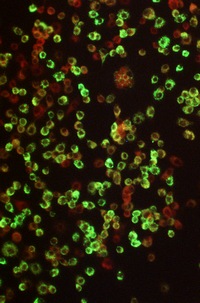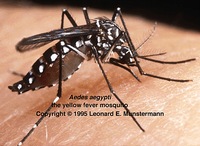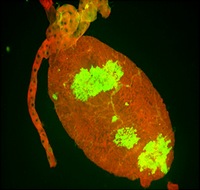
Arthropod-borne viruses (arboviruses) worldwide cause some of the most devastating diseases in humans and animals. Several hundred arbovirus species belonging to five different families of RNA viruses, Bunyaviridae, Flaviviridae, Reoviridae, Rhabdoviridae, and Togaviridae have been identified so far. Arboviruses are orally acquired by their hematophagous vectors along with the viremic blood of infected vertebrate hosts. The viruses need to systemically infect their arthropod vectors in which they are non-pathogenic before being transmitted via saliva to new vertebrate hosts. The majority of arboviruses is transmitted by mosquitoes or ticks. The epidemiology of arboviruses is closely associated with the ecology of their vectors. In endemic countries the principal strategy to prevent or contain arboviral disease outbreaks is based on vector control measures. Effective vaccines have been developed against only a few arboviruses.

Dengue virus (DENV): Nearly 100 million people are infected annual by dengue virus. In the typical urban disease cycle, dengue virus circulates between mosquitoes and humans. The virus causes a variety of disease symptoms ranging from mild febrile illness to dengue hemorrhagic fever or dengue shock syndrome. Dengue has emerged as a worldwide problem only since the 1950s. Dengue rarely occurs in the United States, but it is endemic in Puerto Rico, Latin America and Southeast Asia.

Sindbis virus: Periodically causes non-fatal disease outbreaks among humans in northern Europe. The virus typically circulates between migrating birds and Culex mosquito species with humans being dead-end hosts. SINV provides an excellent laboratory model for the study of arbovirus-mosquito interactions. Recombinant infectious clones of the virus have been engineered, which can be used for heterologous gene expression in vectors and hosts.
Chikungunya virus (CHIKV): An emerging alphavirus of the Old World causing severe arthralgia in humans. The virus is not present in the U.S.; however, recent CHIKV outbreaks in Europe illustrate the spreading of the virus through international travel and traffic. Like DENV, CHIKV circulates between humans and mosquitoes.
Scientists at the LIDR investigate the molecular interactions between Ae. aegypti (mosquitoes) and DENV, SINV, and CHIKV to develop novel control strategies, which are aimed at interrupting the viral disease cycle in the vector. Research focuses on the vector’s innate immune pathways and tissue barriers as modulators of arbovirus infection. In LIDR we perform virus infections of mosquitoes and virus detection assays.